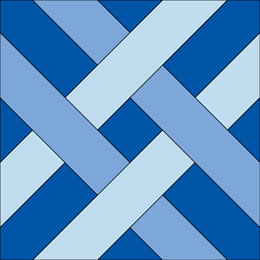|
Irish Plaid
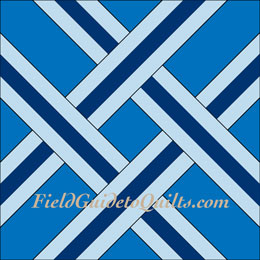 Irish Plaid
Cabot, per Brackman Irish Plaid
Cabot, per Brackman   
   
   
    Irish Plaid (Cabot, per Brackman)
Irish Plaid (Cabot, per Brackman)
 Barbara Brackman attributes this block to designer Nancy Cabot of the Chicago Tribune. Barbara Brackman attributes this block to designer Nancy Cabot of the Chicago Tribune.
Irish Plaid
   
   
   
    Irish Plaid (Cabot, per Malone)
Irish Plaid (Cabot, per Malone)
 Irish Plaid
Cabot, per Malone Irish Plaid
Cabot, per Malone
|
|
The Four Corners
 The Four Corners
Cabot, 1936 The Four Corners
Cabot, 1936 Nancy Cabot is credited with this block, which appeared in the Chicago Tribune in 1936. Nancy Cabot is credited with this block, which appeared in the Chicago Tribune in 1936.
We have not found it on the Web, so we've posted a diagram. Click the "Make it!" icon to see it. We've chosen the colors to show the seams.
|
|
Interlocked Squares
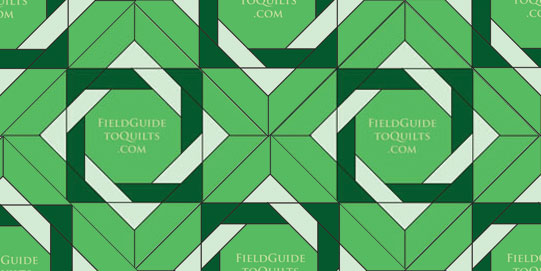 
 
 
 
Interlocked Squares
 Interlocked Squares
Foland, 1932 Interlocked Squares
Foland, 1932  The Kansas City Star's Eveline Foland designed this block, which was shown on point (turned 45 degrees) when it was published in the Star in 1932. The Kansas City Star's Eveline Foland designed this block, which was shown on point (turned 45 degrees) when it was published in the Star in 1932.
We've included an off-point mockup too.
The block is available on the web in both a simplified version and a paper-pieced version with a star in the center. The simple version requires joining a web site and the complex one costs money. We've posted a diagram instead.
|
|
Interlaced Blocks
 Interlaced Blocks
Ladies Art Company Interlaced Blocks
Ladies Art Company
#326, 1897
This wonderful but tricky block from the Ladies Art Company has a log cabin design on the lower left half and a woven bar design on the upper right.
True Lover's Knot is the name that Capper's magazine gave the block in 1931.
Interlaced Blocks was drawn on an 11 x 11 grid. The LAC's mail-order pattern was 15 inches, meaning that each bar's width was 1.36 inches — an inch plus an increment between 1/3 and 3/8 of an inch.
How and why did they do that?
You can put the blocks together in a cloverleaf — the most popular setting — by adding or removing bars.
 Interlaced Blocks (23") Interlaced Blocks (23") Interlaced Blocks (21") Interlaced Blocks (21")
True Lover's Knot
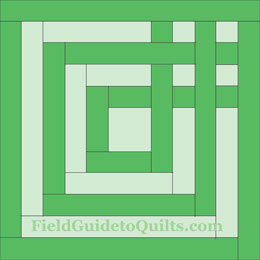   
   
   
   
True Lover's Knot
 True Lover's Knot True Lover's Knot
This block makes for a cloverleaf very like Interlaced Blocks'.
|
Gordian Knot
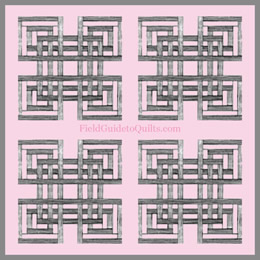 Gordian Knot
Gordian Knot  Gordian Knot
KCS, 1934 Gordian Knot
KCS, 1934
The Kansas City Star's cloverleaf, from 1934, puts a three-inch space between each of four Interlaced Blocks. The Star recommended that the bars (in gray) be made from striped fabric, with the stripes running the length of the bar. If we count correctly, it's 20 squares by 20.
Nancy Cabot presented a virtually identical block a month after the Star did. It was also called Gordian Knot.
In case you were dozing in history class that day, King Midas owned an oxcart that figured in his father Gordias' becoming King of Phyrgia. As the story goes, the cart was tied to a post with a rope that had no ends.
The next king would be the one who untied the impossible knot. Legend has it that Alexander the Great cut through the knot with a single slice of his sword. The most amazing part of that story is that scholars still wonder how much of it is true.
For our whole-quilt layout, we added three inches of space around the outer edge of each block and three inches between each block.
|
|
Carpenter's Square
 Carpenter's Square
Ladies Art Company
Carpenter's Square
Ladies Art Company
#395, 1897
A close look makes you wonder, though, whether the LAC didn't make a mistake in drafting the block. Take a look at the weaving we've illustrated in blue.
Our source is the 1928 catalog, which makes us wonder whether the mistake (assuming it was a mistake) was carried forward with each edition of the catalog.

As published
|

Corrected (maybe) |
|
|
Tangled Garter
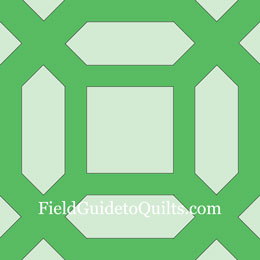 Tangled Garter Tangled Garter
LAC, #124,
1897
"What on earth can be the significance of a "Tangled Garter?" wrote Ruth Finley in Old Patchwork Quilts (1929).
Finley was not writing on deadline, so we're assuming did her research. She is the source of the alternative names we've listed above. Of those, she preferred Garden Maze, but we're going to stick with the Ladies Art Company, which published the block first, in 1897, as its #124.
Finley also wrote that the pattern was "exceedingly popular in the early 19th century."
Beggar Block
 Beggar Block Beggar Block
LAC, #68
1897
Beggar's Block/Cats and Mice/Over and Under Quilt/Spool and Bobbin/Spools and Bobbins/Homespun
We'd call this block from the Ladies Art Company an oddball, but Beggar Block (#68, 1897) spawned no fewer than six other names.
The 1897 block wound up — with the same name — in the Kansas City Star in 1929. The other names above are from Nancy Cabot, Chicago Tribune,1933; Jane Alan, Illinois State Register,1933; Nancy Cabot, Chicago Tribune, 1936, Nancy Page, in the Detroit Free Press, in 1934, and finally, for the next two names, Nancy Page of the Birmingham News,1939.
|
|
Beggar's Block
 Beggar's Block
Page, 1934 Beggar's Block
Page, 1934
Then there's Beggar's Block, a variation of Beggar Block. Nancy Page of the Birmingham News created it by plugging in another one of the hourglass-like miniblocks as the center square.
Page used the first two of the additional names in 1934 and Under and Over in 1941. We've reversed the colors to show the seams. But basically, like Beggar Block itself, it's nine 3x3 miniblocks on a 9x9 grid.
Our source is Beyer's Quilter's Album (2009) for the names, designers, and dates of publication of these and other blocks.
|
